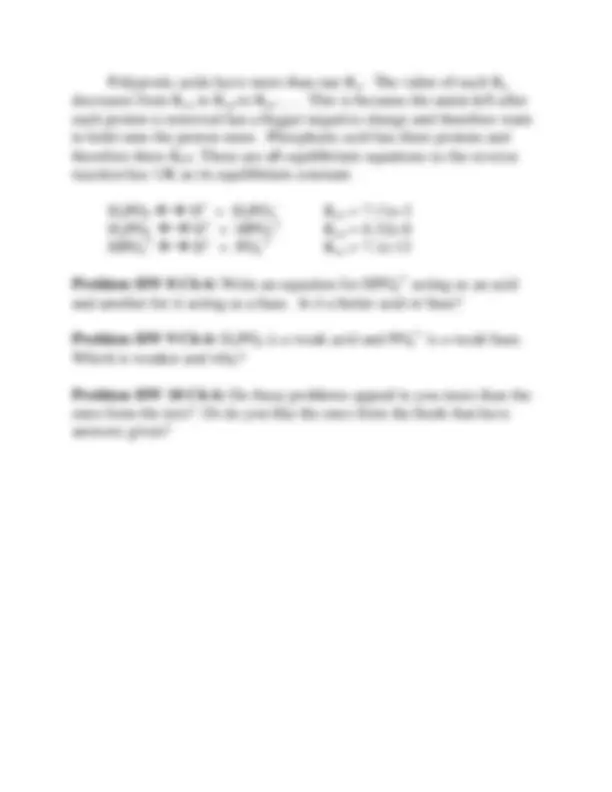



Study with the several resources on Docsity

Earn points by helping other students or get them with a premium plan


Prepare for your exams
Study with the several resources on Docsity

Earn points to download
Earn points by helping other students or get them with a premium plan
Community
Ask the community for help and clear up your study doubts
Discover the best universities in your country according to Docsity users
Free resources
Download our free guides on studying techniques, anxiety management strategies, and thesis advice from Docsity tutors
Information on chemical equilibrium, specifically the formation of copper ammonia complexes and their equilibrium constants. It includes equations for various complexes, their corresponding equilibrium constants, and a discussion on the solubility of the complexes. Students are encouraged to find the concentrations of the complexes given certain conditions and to differentiate between brønsted-lowry and lewis acids and bases.
Typology: Lab Reports
1 / 3

This page cannot be seen from the preview
Don't miss anything!


Do these problems in this instead of the next set from the text book.
More than one reaction may be involved in a complex equilibrium. If so each will have its own equilibrium constant. If true equilibrium exist than all of the equilibrium constant equations must be true simultaneously. In Chem 140 we dealt with complex formation in the Cations Lab. Copper reacted with a small amount of aqueous NH 3 to from insoluble Cu(OH) 2 , but when excess aqueous NH 3 was added the precipitate dissolved.
K (^) sp = [Cu2+^ ][OH-]^2 4.8e-20 (page AP11) K (^) form = β 1 = [CuNH 3 2+^ ] / [Cu 2+^ ][NH 3 ] 9.77e3 (page AP32) β 2 = [Cu(NH 3 ) 2 2+^ ] / [Cu2+^ ][NH 3 ] 2 2.14e7 (page AP32) β 3 = [Cu(NH 3 ) 3 2+^ ] / [Cu2+^ ][NH 3 ] 3 1.15e10 (page AP32) β 4 = [Cu(NH 3 ) 4 2+^ ] / [Cu2+^ ][NH 3 ] 4 1.07e12 (page AP32) Note: β values were calculated from the log values in the table.
The copper ammonia complexes are water soluble and in our experiment we added a large excess of NH 3 so the last reaction was dominate. This was the deep violet colored solution observed.
Cu 2+^ + 4 NH 3 ÅÆ Cu(NH 3 ) 4 2+
Remember that most charge ions are soluble so CuNH 3 2+^ , Cu(NH 3 ) 2 2+, Cu(NH 3 ) 3 2+, and Cu(NH 3 ) 4 2+^ would all be soluble but Cu(OH) 2 with no charge would be insoluble. In the reaction above the Cu 2+^ acts like a Lewis acid (an electron pair acceptor) and the NH 3 acts as the Lewis base (electron pair donor). Lewis bases usually have non- bonding electron pairs and can be either neutral molecules (NH 3 ) or anions (CN - ).
Problem HW 1 Ch 6: Assume the [OH - ] is constant at 0.000100 M and the NH 3 concentration is 0.01 M find the concentration of all of the complexes indicated above. This is a BA problem so it takes time.
We have used Brønsted-Lowry acids and bases and now we are using Lewis acids and bases. Remember that a Brønsted-Lowry acid is a proton (H+^ ) ion donor and a base is a proton acceptor.
Problem HW 2 Ch 6: Write any Brønsted-Lowry reaction indicating which material is the acid, base, conjugate acid, and conjugate base.
Problem HW 3 Ch 6: Write any Lewis reaction indicating which material is the acid and which is the base. Be sure this reaction is not a Brønsted-Lowry reaction.
The pH is calculated using the equation pH = - log 10 [H+^ ].
Problem HW 4 Ch 6: What is the pH of a 0.0000123 M solution of HCl (a strong acid)?
Problem HW 5 Ch 6: What is the pH of a 2.77e-4 M solution of NaOH (a strong base)?
Problem HW 6 Ch 6: The pH of a 1.00e-8 M HCl solution is not 8. Explain why.
Weak acids and bases are much more common than strong acids and bases. Acetic acid is a weak acid with K (^) a = 1.75e-5. Ammonia is a weak base Kb = 1.75e-5. The acetate ion (CH 3 COO - ) is a weak base K (^) b = 5.7e-10 and NH 4 +^ is a weak acid Ka = 5.7e-10. The product the Ka and the Kb for a given material (i.e. acetic acid and the acetate ion) is equal to K (^) w (1.00e-14).
Problem HW 7 Ch 6: Find the Kb value for the F-^ ion.